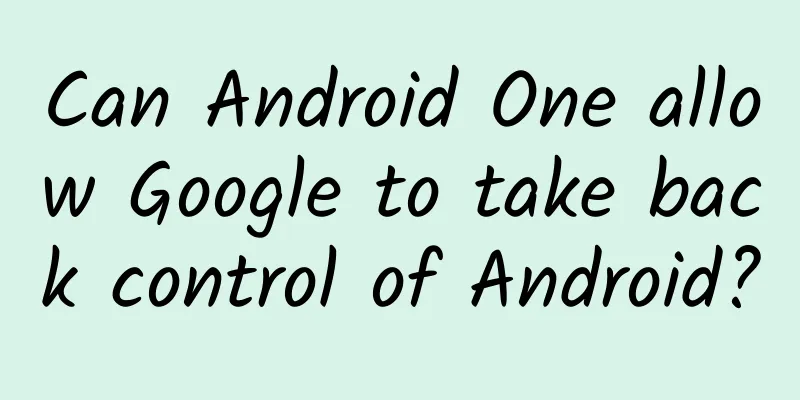Can Android One allow Google to take back control of Android?

|
While iPhone 6 and iPhone 6S have become a hot topic in the industry recently, Google, Apple's biggest rival in the smartphone market, has launched three low-priced smartphones based on Android One system at this year's I/O conference in cooperation with local manufacturers. In addition to the low price, what impressed us about Android One system smartphones is that Google has taken charge of everything from hardware reference design to system and software upgrades. So why is Google so keen on providing such a full set of services to OEM manufacturers? The industry knows that Google's Android currently has more than 80% of the smartphone market share. Despite this, Google has not benefited much from it, or its income is disproportionate to the current market share of Android. Since the Android system is free, Google cannot obtain revenue through licensing fees like Microsoft does with Windows in the PC industry, but can only obtain revenue from Google-related applications. This is also the original intention of Google to release the open source and free Android system. As the saying goes, everything has its pros and cons. Although open source and free have allowed Android to catch up and surpass Apple's iOS in market share, and even left Microsoft, which entered the smartphone market earlier than itself, far behind, smartphone OEMs and operators, for their own commercial interests, have delayed or even cancelled the upgrade of the Android system in the smartphones that have been sold, resulting in the fragmentation of the Android system. What Google didn't expect was that some manufacturers even launched so-called customized Android systems for their own smartphones, such as Amazon Kindle Fire and Nokia's Nokia X (now banned by Microsoft). These customized Android systems have played a role in fragmenting the Android system, and what Google feels is even more dangerous is that these so-called customized Androids all use their own app stores, thereby removing Google's applications. In fact, in addition to Amazon's typical customized Android, international smartphone manufacturers such as Samsung, HTC, and LG have also customized Android and applications to varying degrees. In addition to international manufacturers, this phenomenon is even more serious in the Chinese smartphone market. According to relevant statistics from IDC, in the Chinese smartphone Android market, nearly 2/3 of Android phones are customized to varying degrees by some manufacturers, and pre-install different applications according to their own needs or have their own third-party application stores. But they have one common feature: they are becoming more and more de-Google (Google applications). If this continues, Google will inevitably be in the position of making wedding clothes for others. But facing this situation, it is difficult for Google to change. After all, these manufacturers have become the pillars of Android, although these pillars are very different from Google's original idea of launching Android. And given that the future growth momentum and source of smartphones are more low-end and low-priced smartphones in emerging markets, Google must now intervene, that is, starting from the next new 1 billion users it said, to take back control of Android, at least to let manufacturers adopt their own applications. This is the most fundamental mission of Android One. However, judging from the current competition in the smartphone market and the smartphones based on Android One, the advantages of Google's Android One system phones are not obvious. This advantage is reflected in price and configuration. Looking at the relevant smartphone manufacturers in China, there are already 4G Android phones priced at several hundred yuan on sale. Not only are the prices low, but the configurations are also good. This is the so-called cost-effectiveness. And with the cost-effectiveness, they have occupied nearly 80% of the market share in the Chinese market. What's important is that now these manufacturers focusing on cost-effectiveness are heading to overseas markets, and India is one of their main battlefields. After all, the current penetration rate of smartphones in India is only about 10%, and the growth rate is much higher than that of the Chinese market. This is why when Google first launched the Android One phone in India, its local media commented that since there are already many high-quality and low-priced Android phones on the market, Android One is no longer of much significance to India. Of course, what is more critical is how big the difference is between the current Android One-based phones and the mainstream Android-based phones (in terms of price, experience, applications, etc.). We are not denying that there is no difference, but whether manufacturers based on the mainstream Android system can make prices, configurations and experiences based on the Android One system. If low price is the biggest selling point of Android One system phones, then from the current perspective, phones based on the mainstream Android system can do this (as long as they want to do it), and from the perspective of the market and users, cost-effectiveness seems to be more attractive than simply low prices. As the saying goes, spilled water cannot be reversed. Google chose to open source and make Android free in order to expand its market share and influence. However, open source and free, especially open source, are always a double-edged sword, or the effect of a double-edged sword is more obvious. If it is too open, it will be out of control. If it is too tight, it will violate the principle of open source and may lose the support of the market and users. Today, Google is paying for this effect. Otherwise, it would be in vain. But it is far from enough to take back control of Android with Android One alone. As a winner of Toutiao's Qingyun Plan and Baijiahao's Bai+ Plan, the 2019 Baidu Digital Author of the Year, the Baijiahao's Most Popular Author in the Technology Field, the 2019 Sogou Technology and Culture Author, and the 2021 Baijiahao Quarterly Influential Creator, he has won many awards, including the 2013 Sohu Best Industry Media Person, the 2015 China New Media Entrepreneurship Competition Beijing Third Place, the 2015 Guangmang Experience Award, the 2015 China New Media Entrepreneurship Competition Finals Third Place, and the 2018 Baidu Dynamic Annual Powerful Celebrity. |
<<: Juniper: Global smartphone shipments to reach 1.2 billion this year
>>: Operators take action: Is the nightmare of router manufacturers coming?
Recommend
How to use Weibo marketing to create a brand fan festival?
How to use Weibo marketing to create a brand fan ...
3 tips to teach you how to follow the hot spots correctly
There have been many hot events and festivals rec...
If the sunroof was not closed, would the owners of Nanjing Civic be in trouble?
Recently, a Nanjing Civic owner said that he was ...
Information flow advertising data analysis skills!
Information flow advertising often encounters var...
Soul product operation analysis report
In today's society where the Internet is wide...
The underlying logic of event planning and promotion!
When it comes to event planning, what everyone th...
Summary of rumors about the next-generation iPhone: Big screen/ultra-thin/more powerful performance
Apple iPhone 6 has always been highly exposed, and...
How to increase user repurchase rate? Take the fresh food e-commerce APP as an example
The fresh food e-commerce industry continues to r...
Can repeatedly crying poor in the comments section reduce the price of air tickets by 2,000? Is the "reverse domestication" of big data killing familiar customers reliable?
Recently, according to media reports, some netize...
Why did Xiaomi make a 3,000 yuan router?
On the afternoon of June 10, Xiaomi held a press ...
The display effect of 4.7-inch iPhone 6 is like this
What will the iPhone 6 UI look like after it becom...
Does a positive antigen test mean infection? What other questions do you have about antigen testing? Experts explain →
Can antigen testing and nucleic acid testing repl...
Practical knowledge on field marketing gained through spending hundreds of thousands of dollars in practice!
Startup companies have few resources, a shortage ...
Wuwei Mindset: "Trading Sense Training Camp" 238th issue
Resource introduction of the 238th issue of "...
Yang Guozheng's Eye Method + Sanyuan Naqi (3 sets 5.07G)
Yang Guozheng's Shape Parent Eye Method + San...


![[Girls' Emotions] Love psychology to save singles, find a good man to love you](/upload/images/67cc26ab00c4f.webp)






